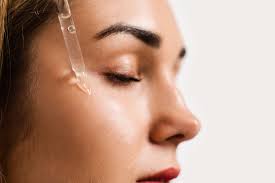The Difference Between Eye Creams And Eye Serums
It happens quite suddenly. One day you’re debating whether banana on toast is a nutritious dinner (it is), and the next you notice your eye area looks a little…older. Fine lines are more of a permanent fixture. So naturally, you start to look for a treatment product. Asap.
Confusingly, there are a lot to choose from: serums, creams, formulas made specifically to hydrate, brighten, de-puff, pay your phone bill. Therefore knowing the difference, and finding the perfect product, can be quite a tricky process. So let us help.
Eye creams are…
Typically rich and buttery in texture (likely the closest in consistency to your daily face moisturiser), eye creams are designed to alleviate dryness and help soften crepey skin. Their formulas rely on emollients, like jojoba oil, and occlusives, like shea butter, to lock in moisture on the skin’s surface and prevent water from evaporating.
Eye serums are…
A touch more innovative. Being lighter in texture, therefore absorbed quicker and deeper into the skin, eye serums offer more treatment-focused results. With little to no emollient or occlusive ingredients they don’t offer the same moisturising benefits as a cream. But their active ingredient component works harder to help correct more concerns, like: dark circles, dark spots, fine lines, loss of collagen and elasticity.
Which product is best suited to me?
Welp, it depends on a few key factors:
Your skin type: This area of the face tends to get thinner and drier with maturity, for everyone.
So! If you’re someone who is already working with dry skin, chances are you’ll need to reach for an eye cream given its intensely moisturising properties. And sensitive skin might benefit more from an eye cream too. Because serums, as you’ve just learned, are a touch more potent (and potentially irritable) (think retinal, hyaluronic acid, vitamin c).
Your skin concern: Eyes are the first place to show signs of tiredness or ageing.
For hydration, smoothness, a general pick-me-up, eye creams can effectively nourish and restore the skin. But if you’re looking to create real change, eye serums are the more efficacious route. Depending on the formula of course, they have the power to improve the appearance of dark circles, dark spots, fine lines, and sagging.
Your skincare routine: There are some products best kept for the AM, others the PM.
It can be particularly beneficial to use an eye cream at night, because the product’s richness is then given ample time to sink into the skin while you sleep. Which is when the skin is in its most regenerative state.
Because of their ability to absorb quickly without leaving behind any residue, eye serums are especially great for AM use and being layered in your skincare (and therefore, makeup) routine.
Can I use both?
You can! Layer away! Thinnest to thickest, as always! Or alternate between the two – reserving serums for the morning and creams for the evening. This is really a question of personal preference.
Eye serums are known to pack more of a punch long term, but they might not be as comforting on a daily basis. So if your eyes are screaming for some extra TLC, why not try both.
DQH Can I use salicylic acid first and then vitamin C?
It’s easy to create a skincare routine, but knowing how to use it is another thing entirely. In most cases, if you’re not getting the desired skin results, it could be due to the layering of conflicting ingredients. So, is it possible that salicylic acid and vitamin C are such ingredients? Or are these active ingredients the duo that’s been missing from your skincare routine? If you want answers, stick around because today we are going to explain the benefits of salicylic acid and vitamin C and how they can be used in your daily life.
What are the benefits of salicylic acid for skin?
Salicylic acid is one of the most commonly used beta hydroxy acids and is favored by many people with oily, acne-prone skin. This acid is derived from willow bark, and unlike its water-soluble relatives (called alpha-hydroxy acids), salicylic acid is oil-soluble, which means it can penetrate deeper into the lower layers of the skin. Once it reaches the lower layers, it can help unclog pores of excess sebum, dirt, bacteria, debris, and impurities. This results in clearer skin tones and greater definition.
Not only does salicylic acid benefit the underlying layers, but the outer surface of the skin benefits as well. When applied to the skin, salicylic acid removes the buildup of dead skin cells. This is accomplished by breaking the bonds that hold dead cells to the surface. Over time, this can cause the complexion to look dull and prone to acne, blackheads, and other blemishes.
If you’d like to learn more about salicylic acid and how it can improve your skin, check out this dedicated blog post from a beauty insider.
What are the benefits of vitamin C for skin?
Vitamin C is considered one of the most powerful antioxidants, which means it is very effective at fighting free radicals and preventing them from causing further skin damage. Examples of free radicals include pollution, central heating, UV rays and harsh climate. They attack proteins, fats and cell membranes as soon as they come into contact with the skin, causing signs of premature aging such as fine lines and wrinkles as well as hyperpigmentation, flaky patches of skin and loss of elasticity.
Many people usually prefer to use vitamin C in their morning routine as this ingredient gives the complexion a radiant glow. You’ll also find that vitamin C can target areas of hyperpigmentation, plumping the skin and reducing the appearance of fine lines and wrinkles.
The thing about vitamin C is that there are a lot of outdated studies going back to the 1950s that describe vitamin C as an unstable skin component. Thanks to improvements in modern technology, this is no longer the case as all products now contain a stable form of vitamin C.
Visit The Beauty Insider to learn more about vitamin C. So please check out our blog post.
Can I use salicylic acid first and then vitamin C?
Yes, you absolutely can. In fact, it’s thought that using salicylic acid before using vitamin C ensures it penetrates faster and works faster.
This is an efficient way to utilize two power sources, and the reason has to do with pH. For example, the skin’s natural pH is about 4.7, making it slightly acidic. Salicylic acid and vitamin C are also both acidic, and you’ll find that vitamin C is absorbed quickly into the skin. Therefore, using salicylic acid beforehand can increase the acidity of the skin and allow vitamin C to penetrate into the skin faster.
While this is considered an effective way to combine two powerful ingredients, you need to be aware of your skin type and how it reacts to certain active ingredients. Even people with perfect, normal skin can experience skin sensitivity and irritation. Therefore, always consult a doctor or dermatologist before using any new products on your skin.
It’s also important to follow skin application rules. In this case, you need to use the product correctly to ensure you get the best results for your skin. If you’re not sure what I mean, the basic rule for skin is to start with the thinnest consistency and work your way up to the thickest consistency. This prevents a barrier from forming on the surface, preventing other active ingredients from penetrating the skin.
Can I use salicylic acid at night and vitamin C in the morning?
Yes, absolutely, this is considered the most effective way to get returns without any adverse side effects. This is because there is enough time between applications to ensure that the skin’s pH levels return to balance.
You’ll also find that Vitamin C is rich in antioxidants and is perfect for use in the morning to ensure your skin is protected and looking its healthiest. Due to the small size of salicylic acid molecules, it is an acid that is able to reach the deepest parts of the skin. While this is effective at keeping skin clear, it also increases the risk of irritation and photosensitivity. Therefore, many people prefer to use powerful BHAs in their evening routine without exposure to UV rays, pollution, or harsh weather.
Warning: If you avoid using sunscreen every day, none of these ingredients will do what your skin needs. The combination of chemical peels and powerful ingredients increases the risk of further damage to the skin’s surface. Use SPF 50 every day to keep your skin protected and your lipid barrier healthy, even on cloudy days, keeping your skin in top condition.



